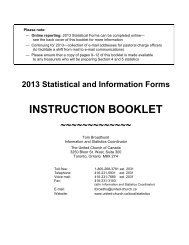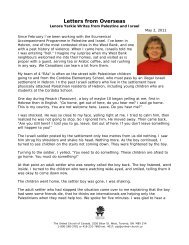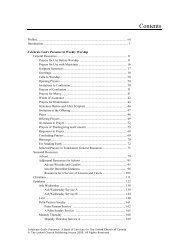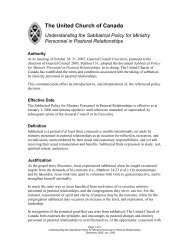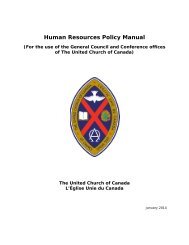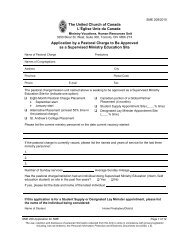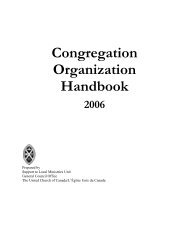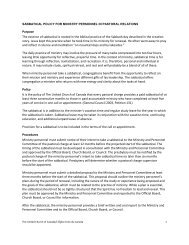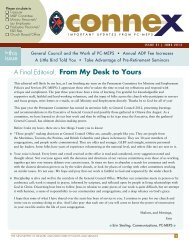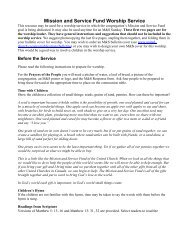Guidelines for Transition Teams - The United Church of Canada
Guidelines for Transition Teams - The United Church of Canada
Guidelines for Transition Teams - The United Church of Canada
You also want an ePaper? Increase the reach of your titles
YUMPU automatically turns print PDFs into web optimized ePapers that Google loves.
Appendix 9: Planning Small Group Meetings<br />
Careful planning will ensure a useful outcome from any small group process. <strong>The</strong> purpose <strong>of</strong> a<br />
group should be carefully thought out be<strong>for</strong>e the process is designed. Exactly describing the focus<br />
and depth <strong>of</strong> participation needed to achieve it can make the difference between a productive process<br />
and an ineffective or incomplete one. <strong>The</strong>n, effective recording ensures that the results become part<br />
<strong>of</strong> the record.<br />
Set the Goals<br />
Be clear about your purposes <strong>for</strong> engaging the group. Consider these related components:<br />
• Need: What is the reason <strong>for</strong> holding this group?<br />
i.e., What is the need? Why a group? Why this group? What outcome is expected?<br />
• Expectations: What is expected <strong>of</strong> group participants?<br />
i.e., To receive in<strong>for</strong>mation? To give in<strong>for</strong>mation? To share viewpoints? To consider options?<br />
To discuss? To make a decision? To agree to take action?<br />
• Anticipated benefits: What will participants experience?<br />
i.e., What will they learn? How do you hope they will feel when they leave?<br />
Plan the Process<br />
Use the goals regarding need, expectations, and benefits as criteria in deciding the following:<br />
• Participants: Who should they be, and how should they be invited and prepared?<br />
• Format: What will be the initial stimuli, key interventions, discussion timing, closing statement?<br />
• Duration and timing: What time will it start and end?<br />
• Leadership: Who is best, and <strong>for</strong> what parts?<br />
• Discussion: How can participants be kept on track and everyone included?<br />
• Outcomes: How will the discussion be recorded?<br />
• Use <strong>of</strong> the Results: How will results be collated? Checked <strong>for</strong> correctness? Communicated?<br />
• Application: How and to whom will the results be communicated?<br />
Evaluate the Outcomes and the Experience<br />
Finally, take time to identify what was learned from this activity. Consider these aspects:<br />
• How effectively did the process deliver the in<strong>for</strong>mation you were aiming <strong>for</strong>?<br />
• How well did the process engage the participants?<br />
• How well did the meeting fulfill its purpose?<br />
• Were there any unexpected outcomes or other factors that affected the process?<br />
• What has this experience added to the self-study? What else is needed?<br />
<strong>Guidelines</strong> <strong>for</strong> <strong>Transition</strong> <strong>Teams</strong> 53



